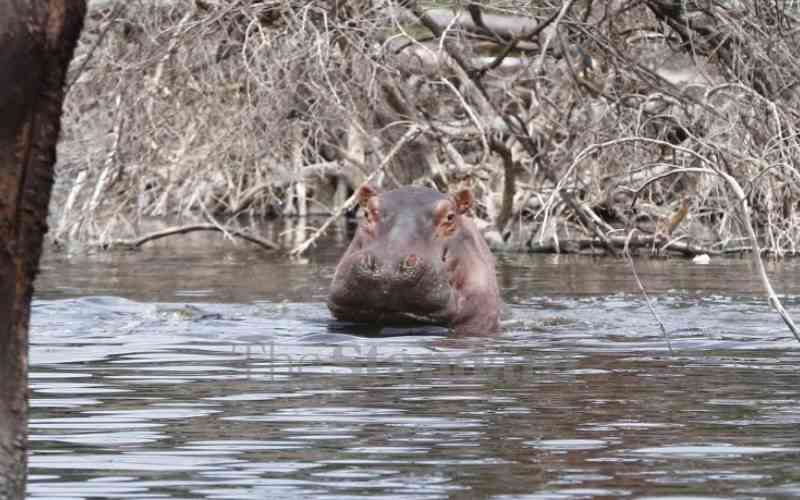By Antony Gitonga
From the eastern escarpment of the Rift Valley, the turquoise reflection of Lake Naivasha yonder lures the eye to approach its shores.
But once there, the picture of one of Kenya’s big fresh water lakes changes to muddy shores and fallen trees, from where the water has receded almost one kilometre from the original shoreline.
A huge generator installed to pump water out of the lake by one of the more than 50 flower farms that draw from it rattles above the sound of the wind.
From the hills kilometres away, smoke can be seen rising to the sky as illegal charcoal burners continue destroying catchment areas that feed water into the lake.
Waters from River Malewa, Karate and Gilgil, which are the main tributaries to the lake, have dried up.
Raw Sewerage
The only liquid flowing into the once fresh lake is raw sewerage from the town, as the sewer plant collapsed months ago.
Effluent from some flower farms also find their way to the lake that is slowly turning into murky waters.
That was the scenario that yesterday awaited the Water Resources Management Authority (Warma) whose officials toured Naivasha to assess the extent of dangers that threaten to dry up the lake.
The Warma board was concerned over the large number of permits granted to flower farms to extract water from the lake.
Scientists and environmentalists have lately sent high alerts that Lake Naivasha will dry up if no intervention is forthcoming.
Most of the flower farms have resorted to digging deeper canals to reach the receding waterline.
The stubborn water hyacinth weed that has covered a third of the lake, making navigation and fishing near impossible in some areas, compounds the problem.
If the lake dries up, it will be an environmental disaster of unimaginable proportion. The lake is home to a variety of wildlife, over 400 different species of birds and many fish species.
Stay informed. Subscribe to our newsletter
Receding Shores
According to statistics from the Lake Naivasha Growers Group, the lake’s shore has receded by more than five kilometres in the last three years.
And as the lake recedes, some flower farms have taken over the emerging ‘free’ riparian land with small-scale farmers following suit.
A recent research by Mr Dalmas Oyugi, a senior lecturer at Kenya Wildlife Service and Training Institute, paints a grim picture.
He says the 648mm of rainfall received in Naivasha annually cannot sustain the lake’s water levels.
The research shows the lake’s mean depth has dropped by two metres to four metres with River Malewa, the main source of the lake, no longer flowing.
"If River Malewa will not be conserved then I am sorry to say the lake will be no more in a few years to come," says Oyugi.
He says water abstraction by the farmers should be metered, a move echoed by the Worldwide Fund for Nature (WWF).
According to Ms Nancy Njenga from the fund, other threats facing the lake include weak policy enforcement and poor land management.
Poor Communities
"We should change livelihood conditions for rural poor communities around the lake landscape by linking sustainable conservation and livelihood opportunities," she says.
Njenga says so far WWF has assisted in community tree planting initiatives on conservation hotspots in the upper catchment area. Naivasha DC Mohammed Birik says Sh20 million received from the Kazi kwa Vijana fund will be used to plant 5,000 trees in the catchment area.
He said: "The lake situation is really worrying and we shall be holding a major stakeholders’ meeting on the way forward for the lake."
Mr Birik says the Aberdare and Eburru forests, which are the lake’s catchment areas, are facing extinction due to deforestation and farming.
Naivasha MP John Mututho attributes the current low water levels to flower farms.
Mr Mututho lashes out at Cabinet ministers who are engaged in politics even as the Mau Forest, Mara River, Lake Naivasha and other natural resources die.
"The manner in which the lake waters are dropping is worrying and if this trend goes on, the lake will be no more very soon," says Mututho.
Action Time
Mr James Kahora, an environmentalist who has championed the lake’s cause, echoes his sentiments.
Kahora, the executive director, Indigenous Biodiversity Environmental conservation Association, says it is time for action.
"The farmers know that the water is for free and with the drop of water levels, the chemical concentration goes up," he says. Kahora says majority of the farms around the lake do not have wetlands and the chemical runoff washes straight back to the lake.
Despite all the arguments about the lake, one thing is clear; the lake is receding at an alarming rate.
 The Standard Group Plc is a
multi-media organization with investments in media platforms spanning newspaper
print operations, television, radio broadcasting, digital and online services. The
Standard Group is recognized as a leading multi-media house in Kenya with a key
influence in matters of national and international interest.
The Standard Group Plc is a
multi-media organization with investments in media platforms spanning newspaper
print operations, television, radio broadcasting, digital and online services. The
Standard Group is recognized as a leading multi-media house in Kenya with a key
influence in matters of national and international interest.
 The Standard Group Plc is a
multi-media organization with investments in media platforms spanning newspaper
print operations, television, radio broadcasting, digital and online services. The
Standard Group is recognized as a leading multi-media house in Kenya with a key
influence in matters of national and international interest.
The Standard Group Plc is a
multi-media organization with investments in media platforms spanning newspaper
print operations, television, radio broadcasting, digital and online services. The
Standard Group is recognized as a leading multi-media house in Kenya with a key
influence in matters of national and international interest.








